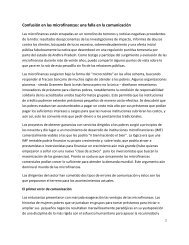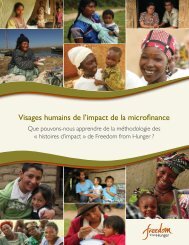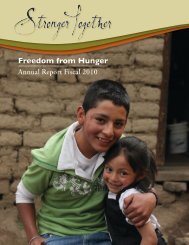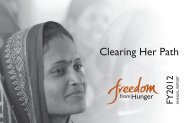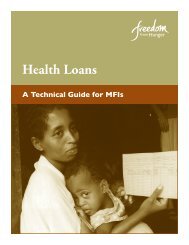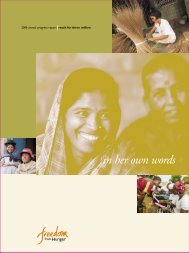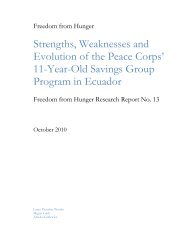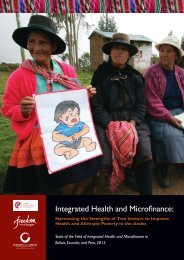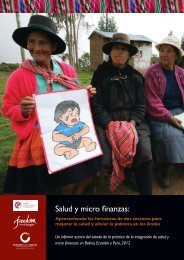history of meals for millions, soy, and freedom from ... - SoyInfo Center
history of meals for millions, soy, and freedom from ... - SoyInfo Center
history of meals for millions, soy, and freedom from ... - SoyInfo Center
You also want an ePaper? Increase the reach of your titles
YUMPU automatically turns print PDFs into web optimized ePapers that Google loves.
SoyaScan Notes. Jan. 9. Conducted by William Shurtleff <strong>of</strong><br />
Soyinfo <strong>Center</strong>.<br />
• Summary: Chris started work with Meals <strong>for</strong> Millions /<br />
Freedom <strong>from</strong> Hunger (FFH) Foundation on 7 Jan. 1982–29<br />
years <strong>and</strong> 2 days ago. The organization now has 42<br />
employees. Christopher Dun<strong>for</strong>d, PhD became president <strong>of</strong><br />
FFH on 1 Feb. 1991 <strong>and</strong> he is still president to this day, but<br />
as <strong>of</strong> 1 July 2011 he will be stepping away <strong>from</strong> that<br />
position. The plan is <strong>for</strong> him to remain on staff so he will be<br />
available as a mentor <strong>and</strong> senior research fellow <strong>for</strong> the<br />
following two years, working on Research <strong>and</strong> Evaluation,<br />
writing “lessons learned” over the 20+ years <strong>of</strong> integrated<br />
micr<strong>of</strong>inance services, <strong>and</strong> creating a learning environment<br />
in the cross-section between micr<strong>of</strong>inance <strong>and</strong> health. Of<br />
course, this is dependent on the new CEO <strong>and</strong> whether that<br />
plan is suitable to him/her. He has had, by far, the longest<br />
term as president in the <strong>history</strong> <strong>of</strong> the organization.<br />
In recent years he has “stuck to his guns” in making<br />
sure the micr<strong>of</strong>inance community does not move away <strong>from</strong><br />
reaching the poorest <strong>of</strong> the poor. In about the year 2000<br />
there was a big movement in the lending community called<br />
“commercialization” or “going upscale.” Every banker<br />
knows that it is easier to loan money to people who already<br />
have a fair amount <strong>of</strong> it than it is to people who are in need<br />
<strong>of</strong> it. At this time even micr<strong>of</strong>inance was starting to move in<br />
this direction, leaving the poor behind–one more time. So<br />
Freedom <strong>from</strong> Hunger (along with Sam Daley-Harris <strong>of</strong><br />
Microcredit Summit Campaign {Washington, DC}) became<br />
a voice <strong>of</strong> opposition to movement in this direction. The<br />
Grameen Bank, founded by Muhammad Yunus in<br />
Bangladesh, was not as vocal as FFH, but they were<br />
definitely staying with their original ideals <strong>and</strong> cheering<br />
FFH. Eventually (in about 2002) the U.S. Congress passed a<br />
law stating that 50% <strong>of</strong> all funding <strong>from</strong> USAID <strong>for</strong><br />
micr<strong>of</strong>inance has to go the poorest <strong>of</strong> the poor. At that point<br />
the question arose: How do we measure poverty? So FFH’s<br />
evaluation team (headed by Christopher Dun<strong>for</strong>d) started to<br />
get involved in actual poverty measurement tools.<br />
In the early 1990s, when FFH started its program <strong>of</strong><br />
Credit with Education, which made small loans to poor<br />
women <strong>and</strong> provided valuable in<strong>for</strong>mation with the loans,<br />
Christopher Dun<strong>for</strong>d realized that it would be essential to<br />
measure the results <strong>of</strong> the new program to see if it was<br />
working, <strong>and</strong> if it was working better than money alone–<br />
without the innovation <strong>of</strong> education. He said, “We need to<br />
prove that its working” <strong>and</strong> to measure the impact. Its all<br />
about food security, plus the health <strong>and</strong> nutrition <strong>of</strong> the<br />
mothers <strong>and</strong> the children. FFH has always worked only in<br />
rural villages with very poor people.<br />
Question: During the almost three decades that Chris<br />
has worked <strong>for</strong> FFH, what have been the most important<br />
developments in this organization?<br />
CD: By far the most important change was the move<br />
<strong>from</strong> the Applied Nutrition Program over to micr<strong>of</strong>inance.<br />
MEALS FOR MILLIONS, SOY, AND FREEDOM FROM HUNGER 170<br />
© Copyright Soyinfo <strong>Center</strong> 2011<br />
The Applied Nutrition Program was effective <strong>for</strong> the people<br />
that FFH was reaching, but the evaluations were showing<br />
that the impact was very limited, <strong>and</strong> it was very labor<br />
intensive <strong>and</strong> very expensive–with things such as weighing<br />
babies several times a year. David Crowley, who as<br />
president <strong>of</strong> FFH just be<strong>for</strong>e Dun<strong>for</strong>d, made the decision to<br />
make this major change. But the decision was <strong>for</strong>ced by a<br />
set <strong>of</strong> lay<strong>of</strong>fs in 1988 due to a funding downturn. Of the 29<br />
people on staff, nine were laid <strong>of</strong>f–a third <strong>of</strong> the staff. He<br />
made the decision to lay <strong>of</strong>f the Applied Nutrition Program<br />
staff. Shortly be<strong>for</strong>e this, one <strong>of</strong> the staff had gone to see the<br />
Grameen Bank in Dhaka, Bangladesh. Kathleen Stack (who<br />
is now vice-president) spent about a week in Bangladesh–<br />
which was really the right way to do it. When she came<br />
back she said, “This is really great. But how can we make<br />
the change <strong>from</strong> a hunger <strong>and</strong> nutrition organization to a<br />
new type <strong>of</strong> bank?” It so happened that she <strong>and</strong> Dun<strong>for</strong>d<br />
<strong>and</strong> Ellen Vor der Bruegge (who was a public health<br />
specialist, newly hired at FFH) went together on a trip to<br />
Nepal. The FFH program village in Nepal was an 8-hour<br />
hike <strong>from</strong> where the car dropped them <strong>of</strong>f. They had a<br />
guide, had to <strong>for</strong>d streams, etc. The whole time they were<br />
trekking, they were talking about the Grameen Bank <strong>and</strong><br />
how FFH could suddenly trans<strong>for</strong>m itself into being a new<br />
type <strong>of</strong> organization. On the trek they came up with a<br />
completely new idea: “Why don’t we use the money as the<br />
locomotive <strong>and</strong> the education topics will be the cars in the<br />
train.” This was the origin (worldwide) <strong>of</strong> the innovation <strong>of</strong><br />
linking micr<strong>of</strong>inance with health <strong>and</strong> nutrition education.<br />
Later business education was added to the program. So this<br />
trip to Nepal turned out to be the turning point. FFH began<br />
to make the trans<strong>for</strong>mation slowly, starting micr<strong>of</strong>inance in<br />
only two countries–Mali (in Dec. 1988) <strong>and</strong> Thail<strong>and</strong> (July<br />
1989)–with only 50 women in two countries. Why didn’t<br />
other micr<strong>of</strong>inance organizations think <strong>of</strong> this excellent idea<br />
be<strong>for</strong>e? First, micr<strong>of</strong>inance / microcredit / microlending was<br />
still a relatively new idea. And also, adding the education<br />
component made the process much more complicated <strong>and</strong><br />
expensive–but it turned out to pay <strong>for</strong> itself many times<br />
over. The typical person going to the village to make or<br />
collect loans had a financial background. It became<br />
necessary to teach that person health <strong>and</strong> nutrition topics<br />
<strong>and</strong> train them to communicate those basic ideas (such as<br />
“mosquitoes carry malaria”) to usually illiterate village<br />
women in a way that they would “get it.” This adds many<br />
new layers to the process. For the first ten years, FFH grew<br />
the Credit with Education program very slowly as they<br />
worked to underst<strong>and</strong> the root causes <strong>of</strong> chronic hunger,<br />
malnutrition <strong>and</strong> poverty, <strong>and</strong> the learned the best ways to<br />
address these–including adult learning techniques, using<br />
pictures, games, discussions, demonstrations, etc. Many<br />
different things go into the education topics. By 1999 (ten<br />
years later) FFH was still reaching only 121,316 women.<br />
But over the next ten years, by Dec. 2008, the number <strong>of</strong>



